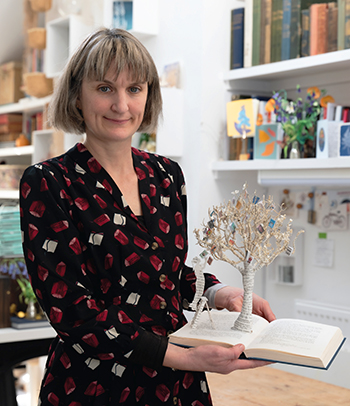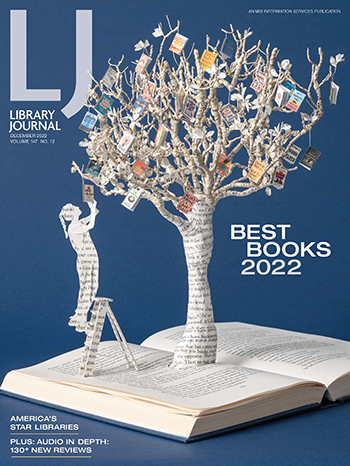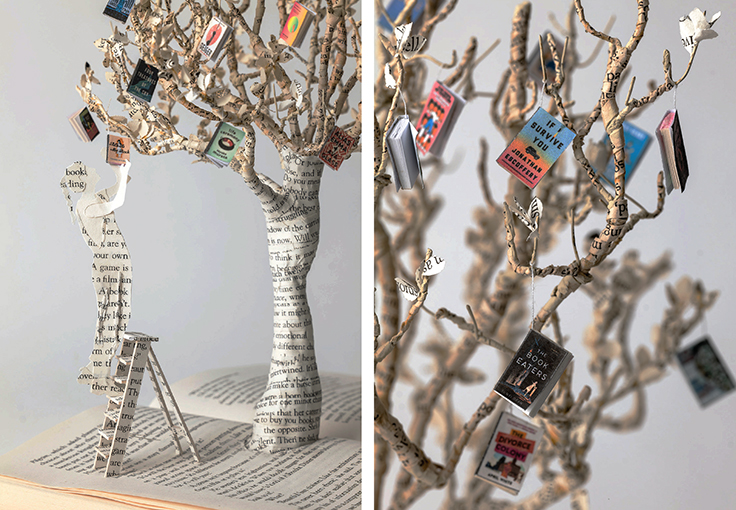LJ Talks to Su Blackwell, Visual Artist, and Creator of Our December Best Books Cover
Su Blackwell is a visual artist known for her book sculptures and book-based installations. She created the art on LJ's December Best Books cover and discusses her work, the creation of the cover, her influences, and reading.
 Su Blackwell is a visual artist known for her book sculptures and book-based installations. She created the art on LJ's December Best Books cover and discusses her work, the creation of the cover, her influences, and reading.
Su Blackwell is a visual artist known for her book sculptures and book-based installations. She created the art on LJ's December Best Books cover and discusses her work, the creation of the cover, her influences, and reading.
 You source your materials from secondhand book shops, selecting works that appeal to you. What makes a book appealing? Are you looking for specific fonts or size of text, for example, or other elements? Is it the story that inspires?
You source your materials from secondhand book shops, selecting works that appeal to you. What makes a book appealing? Are you looking for specific fonts or size of text, for example, or other elements? Is it the story that inspires?
It can be any of those things. It could be the book cover, the title, the story or poems it holds, or the illustrations inside. I am drawn to older books, pre 1950s with hardback covers and tanned, worn pages. The texture of the page is important, but sometimes the content of the book overrides this, and I work with the paper, even if it is very brittle and almost crumbles at the touch. These books are always more challenging.
Your process is to build a complete sculpture from one book, using it as the base and its pages as your materials. How did you pick the book that serves as the source of the sculpture on the LJ cover, and what is it?
I mostly work [with] books printed in the 19th and early 20th century; old books with worn, foxed pages and a history to tell. However, Library Journal felt a modern hardback would be more in keeping with the theme of 'Best Books 2022'. As the turnaround for production was tight, I didn't have a lot of time to source a new book, so I had to work with what I had in the studio. I don't have a huge supply of 'new books' to work with, but I had just finished reading a book called The Golden Rule by Amanda Craig, which references books and authors and reading a lot in its pages. Therefore, it seemed the most suitable book to work with. I scoured its pages, looking for references [to] 'books' and 'reading', and these are the pages, and text which are visible on the open book and wrapped around the tree.
You created individual books for the tree. How did you select those out of the list of 140+ on our best books list, and what are they made from?
[LJ] sent me images of all 140+ titles, split into categories, and I chose around two titles from each category. I was guided by the colors and the legibility of type on the book covers. I printed out the covers on my printer, at miniature-scale, and filled in their pages with blank pages from [The Golden Rule].
Do you create a story for the characters in your pieces and if so, what is the backstory of the figure on the ladder?
Library Journal had seen a sculpture on my website, of historical literary figures, picking books from a tree, as if they were 'apples,' and liked the concept, so for the figure, I felt that she should be on a step ladder...I wanted her to look modern and sassy, so she's wearing a pair of dungarees over a t-shirt.
What is different about your artistic process and approach in doing work for magazine and book covers (or other photography) versus the art that will be displayed as an object? Also, since you are creating 3D sculptures and the photographs are flat and can be taken from any perspective, how do you think through that element of design?
Although the final sculptures are three-dimensional, they are usually only seen from the front-view, because they are displayed inside wooden boxes with a glass front. The backs, which show the supporting wires, are usually hidden. However, in some cases, such as in my 'To Kill a Mockingbird' sculptures, it's important they be viewed 360°, so they are displayed inside glass domes or glass vitrines. When I'm working for book covers and magazine editorials, I usually have a client brief to work to, and fulfill. This doesn't apply with my fine art sculptures, where I am the one setting the brief. I'm therefore able to explore and delve much further into the concepts within my fine art practice. I approach the two quite separately, although the outcomes are sometimes similar.
 You have a unique and multifaceted relationship with books, given that you are a reader of them and create with them. How do you think about them as both sources of stories and as materials? Is a book sometimes only raw material or always both a story experience and a material source? Are you reading to find books to make into pieces? Or does the idea of the piece come first and you try to find a matching book?
You have a unique and multifaceted relationship with books, given that you are a reader of them and create with them. How do you think about them as both sources of stories and as materials? Is a book sometimes only raw material or always both a story experience and a material source? Are you reading to find books to make into pieces? Or does the idea of the piece come first and you try to find a matching book?
It works both ways. Sometimes I'm led by the book. I can be browsing shelves in a second-hand shop, and a title or a cover may resonate with me. That's how it usually starts; a relationship I have with the book. I'm usually also interested in reading the book. It may be a paragraph that stands out, or it could be the general theme of the book. For example, with my book of butterflies and wildflowers, I cut out all of the illustrations from every page inside the book. The book is then full of negative spaces, which I like to bring attention to by adding lighting to create shadows through the cutouts, showing the remnants of where the illustrations used to be. I think there is a poetry to my work, which I find hard to put into words.
Your work is arresting in its expression of enchantment. What elements do you think create this sensibility in your work?
I think the scale of my work alludes to miniature dolls houses and other imaginative childlike games, and that working with the pages of text, makes you focus more on the small details, rather than relying on any color, which would perhaps distract from some of the fine detail. Also, working with the lighting, I incorporate small led bulbs in the work, which either highlight certain areas or create shadows, creating a sense of magic and awe.
Your art is deeply rooted in fairy tales and is very much fairy tale-like itself, as if you have found a doorway to a world made from books and brought a bit back here with you. What elements of fairy tales do you find inspirational?
It's interesting that you put it like that, I think there is an element of surrealism in my work. I'm very much interested in surrealist writing. I like fairy tales, because they are open to interpretation. The stories are usually well-known across the world, and are part of the human psyche. They are full of rich inspiration and retellings.
What are your favorite fairy tales? And beyond fairy tales, classic and modern, what other books do you enjoy reading? Do you have any titles to suggest to our readers?
One of my favorite fairy tales from childhood is Perrault's Little Red Riding Hood, and more recently the Russian fairytale Vasilisa the Brave. It is interesting to explore how these tales have evolved to fit in with changes in society. I am also a fan of Angela Carter's writing. Her retelling of fairy tales in The Bloody Chamber has been very inspiring. For anyone interested in the historical and theoretical study of fairy tales, I recommend reading Marina Warner's Once Upon a Time, for which I designed the cover.
Is there a story you are hoping to one day make into a sculpture that you have yet to make?
I'm working towards an exhibition in London in 2024, where I'll be exploring ecological themes around extinction. Some of the stories I'm interested in exploring are The Nightingale and the Rose by Oscar Wilde, and the German fairy tale Rumpelstiltskin, a tale about 'spinning straw into gold'. I've also just started working with musical notation, which is another 'type' of story.

Artwork by Su Blackwell. Photos by Jaron James
RELATED
ALREADY A SUBSCRIBER? LOG IN
We are currently offering this content for free. Sign up now to activate your personal profile, where you can save articles for future viewing









Add Comment :-
Comment Policy:
Comment should not be empty !!!